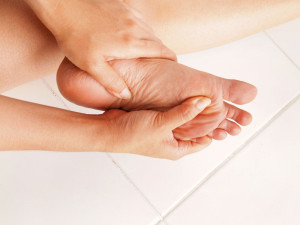Introduction
Foot pain is a common complaint. It is due to a variety of conditions as listed below. Each one of these conditions can make it very difficult to walk for the person who has it and cause limping. It is important that the physician or podiatrist examines the foot carefully and identifies the problem correctly so that a rational therapy can solve the patient’s problem.
In the following I will describe common foot conditions (modified from Ref.1), the diagnostic tests that can be utilized to diagnose them and the therapeutic treatment modalities that are usually followed.
Common Reasons for Foot Pain
bunion : often caused from high heels in women, a deformity of the great toe metatarsophalangeal joint
effects of diabetes on the feet : causes foot ulcers and joint problems
flatfoot (pes planovalgus) : structural collapse of medial longitudinal foot arch
gout : tophi (=uric acid deposits) over joints of great toe
Morton’s neuroma : benign tumor of interdigital nerve at base of toe
nerve root compression : foot pain caused by compression of nerve root (from disc herniation) as explained below
osteoarthritis of the foot : can affect the joints between hindfoot bones and the MTP or the interphalangeal joints
osteochondritis (Freiberg’s and Köhler’s disease) : Freiberg’s: avascular necrosis of second metatarsal bone, mostly in females during puberty; Köhler’s:avascular necrosis of navicular bone in foot on one side of young boys
plantar fasciitis : common with ankylosing spondylitis
rheumatoid arthritis of the foot : destructive arthritis of joints in feet with deformities
sesamoid bone pathology : variations of small bony inclusion of flexor tendons can cause annoying foot pain
stress fracture : overuse (marching) can cause it, but also osteoporosis as explained below
tarsal tunnel nerve compression : burning feeling on sole of foot from compression of medial plantar nerve (needs release)
Stress fracture
Patients who do a lot of running or patients whose bones are osteoporotic, like postmenopausal women without hormone supplementation, can develop little cracks in the bones of the metatarsal shafts, called stress fractures. This leads to a painful forefoot and a bone scan would show the stress fractures right away. Later-on (after about 2 to 4 weeks) when callus bone formation happens during the bony repair, plain X-rays will also show these fracture lines. Treatment consists of rest, some padding like with an air cast and avoidance of strenuous exercises until complete healing. In the case of osteoporosis this condition has to be treated accordingly as indicated elsewhere.
Gout
Often gout starts to declare itself by leading to a painful swollen big toe or an acute gouty first metatarsophalangeal (MP) joint at the base of the big toe. This is so because the circulation is poor in the lower extremity and the uric acid crystals precipitate easiest into the connective tissue at these locations under these circumstances. Gout is described elsewhere also with regard to diagnostic tests and treatment. It is important to treat gout appropriately right away in order to avoid crippling foot deformities.
Nerve root compression
A disc herniation can also lead to pain in the foot by way of referred pain. Usually there are other associated symptoms such as lower back pain, pain and muscle weakness in the leg and numbness in the sole of the foot. This scenario occurs with compression of the S1 nerve root in the case of an L5/S1 disc herniation. When a drop foot develops due to extreme muscle weakness from the S1 nerve root compression, a neurosurgeon or orthopedic surgeon with back surgery experience needs to be consulted to possibly have a discectomy done. Prior to that a CT scan or MRI scan is needed to confirm the clinical diagnosis. Following the surgery early reactivation is needed to return the patient to normal function as soon as possible.
References
1. ABC of rheumatology, second edition, edited by Michael L. Snaith , M.D., BMJ Books, 1999. Chapter 5.
2. The Merck Manual, 7th edition, by M. H. Beers et al., Whitehouse Station, N.J., 1999. Chapter 270.
3. Wheeless’ Textbook of Orthopaedics: http://www.wheelessonline.com/
4. The Merck Manual, 7th edition, by M. H. Beers et al., Whitehouse Station, N.J., 1999. Chapter 60, p.487.
5. Goldman: Cecil Textbook of Medicine, 21st ed.(©2000)W.B.Saunders
6. Ferri: Ferri’s Clinical Advisor: Instant Diagnosis and Treatment, 2004 ed., Copyright © 2004 Mosby, Inc.
7. Rakel: Conn’s Current Therapy 2004, 56th ed., Copyright © 2004 Elsevier







